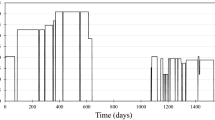Abstract
Correct prediction of the fission products inventory in irradiated nuclear fuels is essential for accurate estimation of fuel burnup, establishing proper requirements for spent fuel transportation and storage, materials accountability and nuclear forensics. Such prediction is impossible without accurate knowledge of neutron induced fission yields. The uncertainty of the fission yields reported in the ENDF/B-VII.0 library is not uniform across all of the data and much of the improvement is desired for certain fissioning isotopes and fission products. We discuss our measurements of cumulative fission yields in nuclear fuels irradiated in thermal and fast reactor spectra using Inductively Coupled Plasma Mass Spectrometry.
Similar content being viewed by others
References
Chadwick MB, Oblozinsky P, Herman M et al (2006) ENDF/B-VII.0: next generation evaluated nuclear data library for nuclear science and technology. Nucl Data Sheets 107:2931–3060
England TR, Rider BF (1994) Evaluation and compilation of fission yields, ENDF-349, LA-UR-94-3106
Lisman FL, Abernathey RM et al (1970) Nucl Sci Eng 42:191–214
Maeck WJ, Emel WA et al (1978) Absolute thermal fission yields for 235U, Allied Chemical Corp.-Idaho Chemical Programs Rept., ICP-1142
Wolf SF, Bowers DL et al (2005) J Radioanal Nucl Chem 263(3):581–586
Zwicky H-U, Low J et al (2004) Isotopic analysis of irradiated fuels samples in the studsvik hotcell laboratory, Proceedings of the 2004 international meeting on LWR fuel performance, Orlando, Florida, paper 1104, 19–22 September 2004
Sullivan VS, Bowers DL (2008) J Radioanal Nucl Chem 277(1):59–64
Clark CR, Moore GA et al (2007) Update on US high density fuel fabrication development, INL/CON-07-12355
Chang GS, Ryskamp JM (2000) Depletion analysis of mixed oxide fuel pins in light water reactors and the advanced test reactor. Nucl Technol 129(3):326–337
X-5 Monte Carlo Team, MCNP-A general Monte Carlo N-particle transport code, version 5, vol 1, LA-UR-03-1987
Croff AG (1983) ORIGEN-2: a versatile computer code for calculating the nuclide compositions and characteristics of nuclear materials. Nucl Technol 62:335–352
Toppel BJ (1983) The fuel cycle analysis capability REBUS-3, ANL-83-2, March 1983
Yang WS, Finck PJ et al (1992) Reconstruction of pin power and burnup characteristics from nodal calculations in hexagonal geometry. Nucl Sci Eng 111:21
McKnight RD (1992) Validation of the REBUS-3/RCT methodologies for EBR-II core-follow analysis, Proceedings of topical meeting on advances in reactor physics. Charleston, SC, March 8–11, 1992, pp 69–80
Bell MJ (1973) ORIGEN-The ORNL isotope generation and depletion code, ORNL-4628
Compilation and evaluation of fission yield nuclear data, 1991–1996, (2000) IAEA-TECDOC-1168, IAEA
Mills RW (1995) Fission product yield evaluation. A Thesis, School of Physics and Space Research, University of Birmingham
Davies W (1970) Absolute measurement of fission yields for 235-uranium and 239-plutonium in the Dounreay fast reactor, LA-4430-MS
Evans RD (1985) The atomic nucleus. Krieger Publishing Company, Florida, p 144
Sommers J, Cummings D et al Advancements in automated gas pressurized extraction chromatography (GPEC) separations. Presentation (Log 109) at the 8th International Conference on Methods and Applications of the Radioanalytical Chemistry, MARC VIII, Kailua-Kona, Hawaii, USA, April 5–10, 2009
Acknowledgments
The authors would like to thank James Sommers, Marcos Jimenez, Cal Morgan and Michael Rodriguez (INL) for preparation and analysis of the fuel samples; Karl Grimm and Richard McKnight (ANL) for reactor physics analysis of EBR-II experiments; Misti Lillo and Gray Chang (INL) for the reactor physics analysis of the ATR experiments. We would also like to acknowledge RERTR Program and EBR-II Spent Fuel Treatment Program for irradiated fuel samples. This manuscript has been authored by Battelle Energy Alliance, LLC under Contract No. DE-AC07-05ID14517 with the US Department of Energy. The US Government retains and the publisher, by accepting the article for publication, acknowledges that the US Government retains a nonexclusive, paid-up, irrevocable, world-wide license to publish or reproduce the published form of this manuscript, or allow others to do so, for US Government purposes.
Author information
Authors and Affiliations
Corresponding author
Rights and permissions
About this article
Cite this article
Glagolenko, I., Hilton, B., Giglio, J. et al. Fission yield measurements by inductively coupled plasma mass-spectrometry. J Radioanal Nucl Chem 282, 651–655 (2009). https://doi.org/10.1007/s10967-009-0209-1
Received:
Accepted:
Published:
Issue Date:
DOI: https://doi.org/10.1007/s10967-009-0209-1




